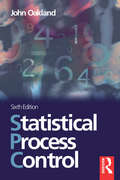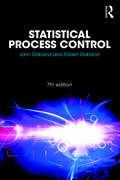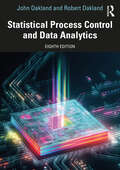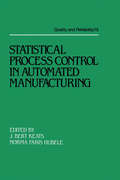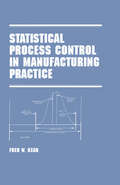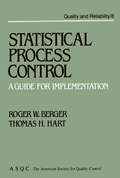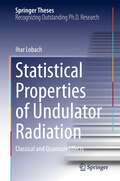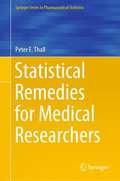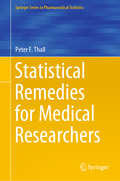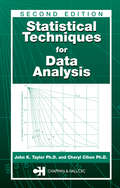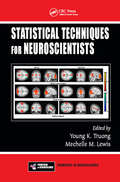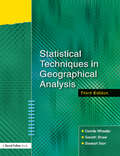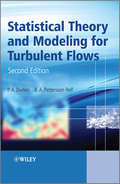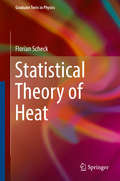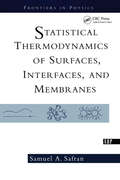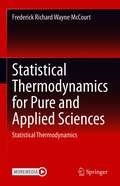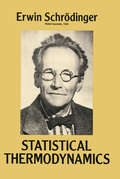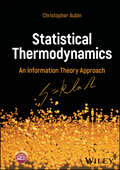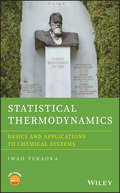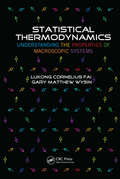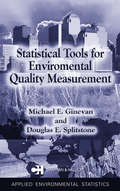- Table View
- List View
Statistical Principles for the Design of Experiments
by R. Mead S. G. Gilmour A. MeadThis book is about the statistical principles behind the design of effective experiments and focuses on the practical needs of applied statisticians and experimenters engaged in design, implementation and analysis. Emphasising the logical principles of statistical design, rather than mathematical calculation, the authors demonstrate how all available information can be used to extract the clearest answers to many questions. The principles are illustrated with a wide range of examples drawn from real experiments in medicine, industry, agriculture and many experimental disciplines. Numerous exercises are given to help the reader practise techniques and to appreciate the difference that good design can make to an experimental research project. Based on Roger Mead's excellent Design of Experiments, this new edition is thoroughly revised and updated to include modern methods relevant to applications in industry, engineering and modern biology. It also contains seven new chapters on contemporary topics, including restricted randomisation and fractional replication.
Statistical Process Control
by John S OaklandStatistical Process Control (SPC) is a tool that measures and achieves quality control, providing managers from a wide range of industries with the ability to take appropriate actions for business success. Offering a complete instructional guide to SPC for professional quality managers and students alike, all the latest tools, techniques and philosophies behind process management and improvement are supported by the author’s extensive consulting work with thousands of organisations worldwide. Fully updated to include real-life case studies, new research based on actual client work from an array of industries, a new chapter on process capability, and integration with the latest computer methods and Minitab software, the book also retains its valued textbook quality through clear learning objectives and end of chapter discussion questions. It will serve as a textbook for both student and practicing engineers, scientists, technologists and managers and for anyone wishing to understand or implement modern statistical process control techniques.
Statistical Process Control
by John S Oakland Robert James OaklandThe business, commercial and public-sector world has changed dramatically since John Oakland wrote the first edition of Statistical Process Control – a practical guide?in the mid-eighties. Then people were rediscovering statistical methods of ‘quality control’ and the book responded to an often desperate need to find out about the techniques and use them on data. Pressure over time from organizations supplying directly to the consumer, typically in the automotive and high technology sectors, forced those in charge of the supplying production and service operations to think more about preventing problems than how to find and fix them. Subsequent editions retained the ‘took kit’ approach of the first but included some of the ‘philosophy’ behind the techniques and their use. The theme which runs throughout the 7th edition is still processes - that require understanding, have variation, must be properly controlled, have a capability, and need improvement - the five sections of this new edition. SPC never has been and never will be simply a ‘took kit’ and in this book the authors provide, not only the instructional guide for the tools, but communicate the management practices which have become so vital to success in organizations throughout the world. The book is supported by the authors' extensive and latest consulting work within thousands of organisations worldwide. Fully updated to include real-life case studies, new research based on client work from an array of industries, and integration with the latest computer methods and Minitab software, the book also retains its valued textbook quality through clear learning objectives and end of chapter discussion questions. It can still serve as a textbook for both student and practicing engineers, scientists, technologists, managers and for anyone wishing to understand or implement modern statistical process control techniques.
Statistical Process Control and Data Analytics
by John Oakland Robert OaklandThe business, commercial and public-sector world has changed dramatically since John Oakland wrote the first edition of Statistical Process Control in the mid-1980s. Then, people were rediscovering statistical methods of ‘quality control,’ and the book responded to an often desperate need to find out about the techniques and use them on data. Pressure over time from organizations supplying directly to the consumer, typically in the automotive and high technology sectors, forced those in charge of the supplying, production and service operations to think more about preventing problems than how to find and fix them. Subsequent editions retained the ‘tool kit’ approach of the first but included some of the ‘philosophy’ behind the techniques and their use.Now entitled Statistical Process Control and Data Analytics, this revised and updated eighth edition retains its focus on processes that require understanding, have variation, must be properly controlled, have a capability and need improvement – as reflected in the five sections of the book. In this book the authors provide not only an instructional guide for the tools but communicate the management practices which have become so vital to success in organizations throughout the world. The book is supported by the authors' extensive consulting work with thousands of organizations worldwide. A new chapter on data governance and data analytics reflects the increasing importance of big data in today’s business environment.Fully updated to include real-life case studies, new research based on client work from an array of industries and integration with the latest computer methods and software, the book also retains its valued textbook quality through clear learning objectives and online end-of-chapter discussion questions. It can still serve as a textbook for both student and practicing engineers, scientists, technologists, managers and anyone wishing to understand or implement modern statistical process control techniques and data analytics.
Statistical Process Control in Automated Manufacturing
by Bert KeatsThis book provides an introduction to statistical process control in automated manufacturing and suggests implementation strategies. It focuses on time series applications in statistical process control and explores the role of knowledge-based systems in process control.
Statistical Process Control in Manufacturing Practice
by Fred W. KearEmphasizing the importance of understanding and reducing process variation to achieve quality manufacturing performance, this work establishes how statistical process control (SPC) provides powerful tools for measuring and regulating manufacturing processes. It presents information derived from time-tested applications of SPC techniques at on-site process situations in manufacturing. It is designed to assist manufacturing organizations in explaining and implementing successful SPC programmes.
Statistical Process Control: A Guide for Implementation (Quality And Reliability Ser. #8)
by Roger W. Berger Thomas H. HartThis guide aims to strip away the mystery surrounding statistical process control and to present its concepts and principles in as simple and straightforward a manner as possible. It is directed primarily at American business managers.
Statistical Properties of Undulator Radiation: Classical and Quantum Effects (Springer Theses)
by Ihar LobachThis thesis presents significant advances in the understanding of the statistical properties of undulator radiation via two experiments carried out in the Integrable Optics Test Accelerator (IOTA) storage ring at Fermilab. The first experiment studied the turn-to-turn fluctuations in the power of the radiation generated by an electron bunch. The magnitude of these fluctuations depends on the 6D phase-space distribution of the electron bunch. The author presents the most complete theoretical description of this effect to date, and shows that it can be used to measure some electron bunch parameters (e.g. its size and divergence). Remarkably, the performance of this technique improves for smaller bunches and shorter radiation wavelengths and it may, therefore, be particularly beneficial for existing state-of-the-art and next-generation low-emittance high-brightness x-ray synchrotron light sources. In the second experiment, a single electron was stored in the ring, emitting a photon only once per several hundred turns. In this regime, any classical interference-related collective effects were eliminated, and the quantum fluctuations could be studied in detail to search for possible deviations from the expected Poissonian photon statistics. In addition, the photocount arrival times were used to track the longitudinal motion of a single electron and to compare it with simulations. This served as an independent measurement of several dynamical parameters of the storage ring.
Statistical Remedies for Medical Researchers (Springer Series in Pharmaceutical Statistics)
by Peter F. ThallThis book illustrates numerous statistical practices that are commonly used by medical researchers, but which have severe flaws that may not be obvious. For each example, it provides one or more alternative statistical methods that avoid misleading or incorrect inferences being made. The technical level is kept to a minimum to make the book accessible to non-statisticians. At the same time, since many of the examples describe methods used routinely by medical statisticians with formal statistical training, the book appeals to a broad readership in the medical research community.
Statistical Remedies for Medical Researchers (Springer Series in Pharmaceutical Statistics)
by Peter F. ThallThis book illustrates numerous statistical practices that are commonly used by medical researchers, but which have severe flaws that may not be obvious. For each example, it provides one or more alternative statistical methods that avoid misleading or incorrect inferences being made. The technical level is kept to a minimum to make the book accessible to non-statisticians. At the same time, since many of the examples describe methods used routinely by medical statisticians with formal statistical training, the book appeals to a broad readership in the medical research community.
Statistical Techniques for Data Analysis
by John K. Taylor Cheryl CihonSince the first edition of this book appeared, computers have come to the aid of modern experimenters and data analysts, bringing with them data analysis techniques that were once beyond the calculational reach of even professional statisticians. Today, scientists in every field have access to the techniques and technology they need to analyze stat
Statistical Techniques for Neuroscientists (Foundations and Innovations in Neurobiology)
by Young K. Truong Mechelle M. LewisStatistical Techniques for Neuroscientists introduces new and useful methods for data analysis involving simultaneous recording of neuron or large cluster (brain region) neuron activity. The statistical estimation and tests of hypotheses are based on the likelihood principle derived from stationary point processes and time series. Algorithms and software development are given in each chapter to reproduce the computer simulated results described therein. The book examines current statistical methods for solving emerging problems in neuroscience. These methods have been applied to data involving multichannel neural spike train, spike sorting, blind source separation, functional and effective neural connectivity, spatiotemporal modeling, and multimodal neuroimaging techniques. The author provides an overview of various methods being applied to specific research areas of neuroscience, emphasizing statistical principles and their software. The book includes examples and experimental data so that readers can understand the principles and master the methods. The first part of the book deals with the traditional multivariate time series analysis applied to the context of multichannel spike trains and fMRI using respectively the probability structures or likelihood associated with time-to-fire and discrete Fourier transforms (DFT) of point processes. The second part introduces a relatively new form of statistical spatiotemporal modeling for fMRI and EEG data analysis. In addition to neural scientists and statisticians, anyone wishing to employ intense computing methods to extract important features and information directly from data rather than relying heavily on models built on leading cases such as linear regression or Gaussian processes will find this book extremely helpful.
Statistical Techniques in Geographical Analysis
by Gareth Shaw Stewart Barr Dennis WheelerThis volume includes changes in the switch from DOS-based to Windows-based, menu-driven forms of SPSS and MINITAB is the most important. The other change shows availability of data in digital form from websites or via CD-ROMs. The book is useful for teachers and students.
Statistical Theory and Modeling for Turbulent Flows
by P. A. Durbin B. A. ReifProviding a comprehensive grounding in the subject of turbulence, Statistical Theory and Modeling for Turbulent Flows develops both the physical insight and the mathematical framework needed to understand turbulent flow. Its scope enables the reader to become a knowledgeable user of turbulence models; it develops analytical tools for developers of predictive tools. Thoroughly revised and updated, this second edition includes a new fourth section covering DNS (direct numerical simulation), LES (large eddy simulation), DES (detached eddy simulation) and numerical aspects of eddy resolving simulation.In addition to its role as a guide for students, Statistical Theory and Modeling for Turbulent Flows also is a valuable reference for practicing engineers and scientists in computational and experimental fluid dynamics, who would like to broaden their understanding of fundamental issues in turbulence and how they relate to turbulence model implementation.Provides an excellent foundation to the fundamental theoretical concepts in turbulence.Features new and heavily revised material, including an entire new section on eddy resolving simulation.Includes new material on modeling laminar to turbulent transition. Written for students and practitioners in aeronautical and mechanical engineering, applied mathematics and the physical sciences.Accompanied by a website housing solutions to the problems within the book.
Statistical Theory of Heat
by Florian ScheckScheck's textbook starts with a concise introduction to classical thermodynamics, including geometrical aspects. Then a short introduction to probabilities and statistics lays the basis for the statistical interpretation of thermodynamics. Phase transitions, discrete models and the stability of matter are explained in great detail. Thermodynamics has a special role in theoretical physics. Due to the general approach of thermodynamics the field has as a bridging function between several areas like the theory of condensed matter, elementary particle physics, astrophysics and cosmology. The classical thermodynamics describes predominantly averaged properties of matter, reaching from few particle systems and state of matter to stellar objects. Statistical Thermodynamics covers the same fields, but explores them in greater depth and unifies classical statistical mechanics with quantum theory of multiple particle systems. The content is presented as two tracks: the fast track for master students, providing the essentials, and the intensive track for all wanting to get in depth knowledge of the field. Clearly labelled material and sections guide students through the preferred level of treatment. Numerous problems and worked examples will provide successful access to Statistical Physics and Thermodynamics.
Statistical Thermodynamics
by Normand M. LaurendeauStatistical Thermodynamics: Fundamentals and Applications discusses the fundamentals and applications of statistical thermodynamics for beginning graduate students in the engineering sciences. Building on the Maxwell-Boltzmann method of step-by-step development of the subject, this book makes few presumptions concerning students, previous exposure to statistics, quantum mechanics or spectroscopy. The book begins with the fundamentals of statistical thermodynamics, pauses to recover needed knowledge from quantum mechanics and spectroscopy, and then moves on to applications involving ideal gases, the solid state and radiation. A full introduction to kinetic theory is provided, including its applications to transport phenomena and chemical kinetics. Modern applications, such as laser-based diagnostics, are also discussed. Each chapter is carefully written to address student difficulties in learning this challenging subject, which is fundamental to combustion, propulsion, transport phenomena, spectroscopic measurements and nanotechnology. Students are made comfortable with their new knowledge by the inclusion of both example and prompted homework problems.
Statistical Thermodynamics Of Surfaces, Interfaces, And Membranes (Frontiers in Physics #Vol. 90)
by Samuel SafranUnderstanding the structural and thermodynamic properties of surfaces, interfaces, and membranes is important for both fundamental and practical reasons. Important applications include coatings, dispersants, encapsulating agents, and biological materials. Soft materials, important in the development of new materials and the basis of many biological systems, cannot be designed using trial and error methods due to the multiplicity of components and parameters. While these systems can sometimes be analyzed in terms of microscopic mixtures, it is often conceptually simpler to regard them as dispersions and to focus on the properties of the internal interfaces found in these systems. The basic physics centers on the properties of quasi-two-dimensional systems embedded in the three-dimensional world, thus exhibiting phenomena that do not exist in bulk materials. This approach is the basis behind the theoretical presentation of Statistical Thermodynamics of Surfaces, Interfaces, and Membranes. The approach adapted allows one to treat the rich diversity of phenomena investigated in the field of soft matter physics (including both colloid/interface science as well as the materials and macromolecular aspects of biological physics) such as interfacial tension, the roughening transition, wetting, interactions between surfaces, membrane elasticity, and self-assembly. Presented as a set of lecture notes, this book is aimed at physicists, physical chemists, biological physicists, chemical engineers, and materials scientists who are interested in the statistical mechanics that underlie the macroscopic, thermodynamic properties of surfaces, interfaces, and membranes. This paperback edition contains all the material published in the original hard-cover edition as well as additional clarifications and explanations.
Statistical Thermodynamics and Stochastic Kinetics
by Yiannis N. KaznessisPresenting the key principles of thermodynamics from a microscopic point of view, this book provides engineers with the knowledge they need to apply thermodynamics and solve engineering challenges at the molecular level. It clearly explains the concepts of entropy and free energy, emphasizing key ideas used in equilibrium applications, whilst stochastic processes, such as stochastic reaction kinetics, are also covered. It provides a classical microscopic interpretation of thermodynamic properties, which is key for engineers, rather than focusing on more esoteric concepts of statistical mechanics and quantum mechanics. Coverage of molecular dynamics and Monte Carlo simulations as natural extensions of the theoretical treatment of statistical thermodynamics is also included, teaching readers how to use computer simulations and thus enabling them to understand and engineer the microcosm. Featuring many worked examples and over 100 end-of-chapter exercises, it is ideal for use in the classroom as well as for self-study.
Statistical Thermodynamics and Stochastic Kinetics
by Yiannis N. KaznessisPresenting the key principles of thermodynamics from a microscopic point of view, this book provides engineers with the knowledge they need to apply thermodynamics and solve engineering challenges at the molecular level. It clearly explains the concepts of entropy and free energy, emphasizing key ideas used in equilibrium applications, whilst stochastic processes, such as stochastic reaction kinetics, are also covered. It provides a classical microscopic interpretation of thermodynamic properties, which is key for engineers, rather than focusing on more esoteric concepts of statistical mechanics and quantum mechanics. Coverage of molecular dynamics and Monte Carlo simulations as natural extensions of the theoretical treatment of statistical thermodynamics is also included, teaching readers how to use computer simulations and thus enabling them to understand and engineer the microcosm. Featuring many worked examples and over 100 end-of-chapter exercises, it is ideal for use in the classroom as well as for self-study.
Statistical Thermodynamics for Pure and Applied Sciences: Statistical Thermodynamics
by Frederick Richard McCourtThis textbook concerns thermal properties of bulk matter and is aimed at advanced undergraduate or first-year graduate students in a range of programs in science or engineering. It provides an intermediate level presentation of statistical thermodynamics for students in the physical sciences (chemistry, nanosciences, physics) or related areas of applied science/engineering (chemical engineering, materials science, nanotechnology engineering), as they are areas in which statistical mechanical concepts play important roles. The book enables students to utilize microscopic concepts to achieve a better understanding of macroscopic phenomena and to be able to apply these concepts to the types of sub-macroscopic systems encountered in areas of nanoscience and nanotechnology.
Statistical Thermodynamics: A Course Of Seminar Lectures Delivered In January (Dover Books On Physics Series)
by Erwin SchrodingerIn this concise volume, one of the founder of quantum mechanics and one of the greatest theoretical physicists of the century (Nobel laureate, 1933) attempts to develop a simple, unified standard method of dealing with all cases of statistical thermodynamics (classical, quantum, Bose-Einstein, Fermi-Dirac, etc.)The level of discussion is relatively advanced. As Professor Schrödinger remarks in the Introduction: "It is not a first introduction for newcomers to the subject, but rather a 'repetitorium.' The treatment of those topics which are to be found in every one of a hundred text-books is severely condensed; on the other hand, vital points which are usually passed over in all but the large monographs (such as Fowler's and Tolman's) are dealt with at greater level."
Statistical Thermodynamics: An Information Theory Approach
by Christopher AubinStatistical Thermodynamics An accessible and rigorous approach to thermodynamics and statistical mechanics In Statistical Thermodynamics: An Information Theory Approach, distinguished physicist Dr. Christopher Aubin delivers an accessible and comprehensive treatment of the subject from a statistical mechanics perspective. The author discusses the most challenging concept, entropy, using an information theory approach, allowing readers to build a solid foundation in an oft misunderstood and critically important physics concept. This text offers readers access to complimentary online materials, including animations, simple code, and more, that supplement the discussions of complex topics in the book. It provides calculations not usually provided in comparable textbooks that demonstrate how to perform the mathematics of thermodynamics in a systematic way. Readers will also find authoritative explorations of relevant theory accompanied by clear examples of applications and experiments, as well as: A brief introduction to information theory, as well as discussions of statistical systems, phase space, and the Microcanonical Ensemble Comprehensive explorations of the laws and mathematics of thermodynamics, as well as free expansion, Joule-Thomson expansion, heat??engines, and refrigerators Practical discussions of classical and quantum statistics, quantum ideal gases, and blackbody radiation Fulsome treatments of novel topics, including Bose-Einstein condensation, the Fermi gas, and black hole thermodynamics Perfect for upper-level undergraduate students studying statistical mechanics and thermodynamics, Statistical Thermodynamics: An Information Theory Approach provides an alternative and accessible approach to the subject.
Statistical Thermodynamics: Basics and Applications to Chemical Systems
by Iwao TeraokaThis textbook introduces chemistry and chemical engineering students to molecular descriptions of thermodynamics, chemical systems, and biomolecules. Equips students with the ability to apply the method to their own systems, as today's research is microscopic and molecular and articles are written in that language Provides ample illustrations and tables to describe rather difficult concepts Makes use of plots (charts) to help students understand the mathematics necessary for the contents Includes practice problems and answers
Statistical Thermodynamics: Understanding the Properties of Macroscopic Systems
by Lukong Cornelius Fai Gary Matthew WysinPresenting a look at the modern evolution of statistical thermodynamics, this book provides a detailed overview of the statistical principles used to obtain the physical and thermodynamic properties of macroscopic systems. Going further than many advanced textbooks, it includes Bose-Einstein, Fermi-Dirac statistics, and lattice dynamics as well as applications in polaron theory, electronic gas in a magnetic field, thermodynamics of dielectrics, and magnetic materials in a magnetic field. The text also examines statistical thermodynamics using functional integration and Feynman path integrals. In addition, it features physical results and worked problems.
Statistical Tools for Environmental Quality Measurement (Chapman & Hall/CRC Applied Environmental Statistics)
by Douglas E. Splitstone Michael E. GinevanWhen interpreting environmental data, scientists and engineers first must select the correct statistical tool to use for their analysis. By doing this they will be able to make sound decisions in their efforts to solve environmental problems. They need a detailed reference that points out the subtle differences between statistical procedures, makin

